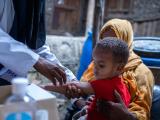Sep 10, 2002 (CIDRAP News) – After the Sep 11 attacks in New York City, health officials quickly launched a program of syndromic surveillance—the classification and counting of emergency department cases according to whether or not they initially looked like a disease potentially caused by bioterrorism. The goal was to provide an early warning of any biological attack.
The Centers for Disease Control and Prevention (CDC) now reports that the program was useful in showing that the Sep 11 attacks did not include biological weapons, but it did not prove that syndromic surveillance can detect a biological attack before clinicians report cases. For example, the program did not detect the cutaneous anthrax cases that cropped up in New York after anthrax-tainted letters were mailed, mainly because most of the patients did not seek treatment in hospital emergency departments (EDs).
"This report highlights the need for more experience with and evaluation of syndromic surveillance," the CDC reports in a special edition of Morbidity and Mortality Weekly Report, dated Sep 11 (2002) but released early. Among other things, the report recommends that state and local health departments use data from other sources besides EDs as they try out syndromic surveillance.
The New York City Department of Health and the CDC began planning the syndromic surveillance program on the evening of Sep 11, patterning it after drop-in surveillance programs used by the CDC at the 2001 Super Bowl and other mass-participation events. Officials picked 15 New York EDs as sentinel sites and designed a form that listed 12 syndromes, such as anxiety, gastrointestinal, inhalational, rash, and trauma. Seven of these were considered to be possible results of exposure to a bioterrorist agent, four were possible results of the World Trade Center attacks but not due to bioterrorism, and one was for presentations that fit neither category ("none of the above"). Healthcare providers were asked to choose the syndrome that seemed to best represent the patient's primary diagnosis. To collect the data, the CDC sent up to three people to each hospital for 30 days.
Seeking suspicious clusters of cases, officials looked at the daily count for each syndrome of interest and divided it by the count for the "none of the above" category. The resulting "syndrome to none ratio" (SNR) for each day was compared with the cumulative baseline ratio for each hospital or group of hospitals. "Alarms were generated when the SNR was significantly higher for the day in question compared with the recent past," the report states.
Between Sep 13 and Oct 12, 68,546 ED visits were recorded. About 71% of these were classified as "none of the above," 20.3% were coded as nonbioterrorism, and 6.4% were in the potential bioterrorism group. "Diarrhea/gastroenteritis and upper- and lower-respiratory infections with fever were the most common syndromes possibly associated with BT, with mean SNRs of 4.4% and 4.2%, respectively," the report says. A total of 91 alarms were registered for syndromes of bioterrorism interest, but resulting investigations "did not reveal any similarity in the cases or final diagnoses suggestive of a natural outbreak or bioterrorist attack." Moreoever, people who had been within 2 miles of the World Trade Center on Sep 11 were no more likely to have symptoms potentially related to bioterrorism than those who had been farther away.
One drawback of the program was the assumption that patients with symptoms possibly related to bioterrorism would report to EDs, the article says. "Although the system was in place, it did not detect the outbreak of anthrax among recipients of anthrax-contaminated letters in NYC in mid-September. Six of the seven patients diagnosed with cutaneous anthrax in NYC did not seek care in EDs." The program was designed to detect outbreaks due to airborne release of pathogens, not single cases or cutaneous cases, the report adds.
Another problem was that symptoms and diagnoses within syndromes varied substantially, making it difficult to decide how far to investigate individual cases. "Only time-consuming laboratory tests provided assurance that no agent of BT concern was implicated," the report says. "Therefore, it [is] difficult to determine whether such ED-based systems can detect a large-scale bioterrorist attack before clinicians report suspected or confirmed cases."
The initial syndromic surveillance program in New York, which involved manual data collection, has since been replaced by an automated system that uses ED "chief complaint logs." The report concludes, "As more state and local health departments are implementing syndromic surveillance systems, public health officials should consider adopting a regional approach with standardized coding algorithms; expansion of data sources to include laboratory, radiology, and outpatient information; and discussions about collaborative methods for rapidly investigating statistically generated aberrations."
CDC. Syndromic
surveillance for bioterrorism following the attacks on the World Trade
Center—New York City, 2001. MMWR 2002;51(special issue):13-15
http://www.cdc.gov/mmwr/preview/mmwrhtml/mm51SPa5.htm




















